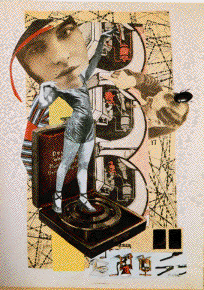
Fall 2004
Screening, M 7-10pm, LPAC Cinema
Class, W 1:15-4pm, LPAC Cinema
Sunka Simon
Office Hours: M/F: 11:30-12:30
Kohlberg #312
x7354, ssimon1
Click-Map (click on any of
the items below to be transported
there):
Texts - Course Reserves - Resources - Glossary
Course Requirements - Nota Bene - Writing Papers - Syllabus
Week 1 - Week 2 - Week 3 - Week 4 - Week 5 - Week 6 - Week 7
Week 8 - Week 9 - Week 10 - Week 11 - Week 12 - Week 13
Course Bibliography - Screen Report Sheet
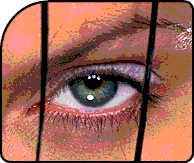
Introduction to Film and Media Studies
The invention of cinema at the end of the 19th century and the recent Y2K computer scare mark a period in which communications technology shaped our world and moving images evolved from the photographic to the digital. This course explores the specificity, history, and function of media forms, focusing on the language of cinema. As an art, a text, a technology, a commercial product, a psychological experience, and a social practice, cinema presents fascinating contradictions for study.
This lecture/discussion course, intended as a general introduction and as the first credit towards a minor or a concentration in Film and Media Studies, has two basic goals. First, it will develop skills in film analysis. You will become fluent in the vocabulary of film form and learn to construct an argument about what a film's sounds and images mean and how it structures and achieves its meanings. Second, it will provide an introduction to the theories, methods, and concerns of film and media studies as a discipline. Realism, auteur cinema, national cinemas, movements and genres, narrative, documentary and avant-garde modes of filmic expression and video and television production will be introduced through readings and screenings, preparing you for further work in the field.
The first part of the course will emphasize specific aspects of film style and narrative form through analysis of scenes from the films screened each week and from a range of outside examples. Each week will introduce historical, cultural and theoretical topics relevant to the films shown while focusing on the films' self-reflexivity of their medium. The second half of the course looks at the politics of image-making from the postwar period to the millennium by examining a range of films with the analytical skills you have acquired.
Texts (available at the College Bookstore)
1, Timothy Corrigan and Patricia White, The Film Experience (2004).(FE)
2. Geoffrey Nowell-Smith, Oxford History of World Cinema (1996) (OWC)
Required Course Readings marked (X) are available on electronic reserve through our weekly course document folders on the Blackboard server. When you enrolled in this class, you automatically registered on our Blackboard site. Go to the Blackboard gateway and login. Here you can access course-related announcements, course documents and this online syllabus.
On regular reserve at McCabe are our course texts as well as pertinent film criticism. Consult Tripod for further material. Kolker's Film Form and Culture has a CD-Rom illustrating concepts we discuss in class.
Supplementary Resources for Research
You can use The Film Experience's website, Bordwell/Thompson's Film Art website, the Internet Movie Database and the resource links on the FMST homepage for production credits, but learn to become familiar with more scholarly resources. Websites can be great assets and make fascinating research topics in the course of our media component, but they are not reliable as quotable resources. Try instead the library's International Film Index, International Index to the Performing Art, and the MLA Index for periodical literature, and our textbooks' extensive bibliographies for further reading.
Consult The Film Experience's glossary and Film Art's Online Glossary while you are reading and writing.
1. Regular Attendance and Class Participation: 15 %
at all screenings* and lectures (more than two absences will effect your grade)
2. 3 full-text Screening Reports: 15%
select three of the screened films from three different weeks and write a report using the pre-formatted screening report (html) or screening report (MS Word) to be handed in by class-time that week
3. 5-6 page film analysis paper** (Week 5): 15%
4. Take-Home Midterm Exam (Week 8): 15%
5. Group Project (Week 10 and 13): 20%
leading class discussion for twenty minutes, incorporating some formal discussion of a chosen film or medium, either through close analysis of one scene, several examples illustrating the week's topic, or a discussion of narrative structure.
6. Final Exam: 20%
Attendance at all screenings is mandatory, unless you previously discussed scheduling conflicts with me. From Thursday to Monday, VHS videos, DVDs and/or Laserdisks will be available for in-house viewing at McCabe for repeated viewing and research papers only! NO videos or dvds may be checked out on Tuesdays or Wednesdays! You can capture frames from videos to illustrate your written work on the computers at the LRC, but it is neither required, nor should this be overused.
1. Check spelling while you type!
2. Proofread!
3. Use a 1-inch margin all around
4. Use double-spacing and Times, Helvetica or New York Fonts
5. Number all pages except your title page
6. Use MLA-style citation (parenthetical reference to author's name and page number in text &endash; e.g. (Bordwell 43) - PLUS a bibliography with full citation at the end)
7. Film Titles need to be underlined or italicized. After the first mention of the title, you include in parenthesis the film's director and year of release &endash; e.g. Dogma (Kevin Smith,1999).
8. When you introduce a significant character's name, include the actor's name in parenthesis &endash; e.g. Lara Croft (Angelina Jolie). This information is readily available from reference works or your own note-taking (another reason to stay for the credits!)
9. You do not need to footnote when quoting dialogue, just introduce the reader to the context of the scene you are about to quote.





FMST001 - Fall 2001
UNIT I: Questions of Form
Week 1 Introduction
8/30 Lord of the Rings: The Return of the King (Peter Jackson, 2003)
9/1: Sherlock, Jr. (Buster Keaton, 1924)
Read:
- FE: Introduction, Preparing Viewers and Views, 5-40; Chapter 9: Conventional Film History, 327-352
- X: Umberto Eco, "Casablanca or the Cliches are Having a Ball" (On Signs)
- X: Lev Manovich, "What is Digital Cinema?"(VCR)
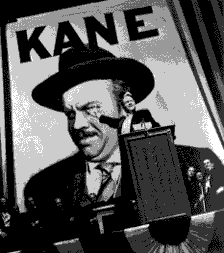
9/6 Citizen Kane (Orson Welles, 1941)
9/8 Clips: Citizen Kane, The Big Sleep (Howard Hawks, 1946)
Read:
- FE: Chapter 6: Telling Stories about Time: Narrative Films, 213-256; Chapter 12: Writing an Analytical Film Essay, 474-483
- X: Raymond Bellour, "The Obvious and the Code" (Narrative, Apparatus, Technology)
- X: Andre Sarris, "Kane: For and Against" (Sight and Sound)
- X: Peter Wollen, "Citizen Kane" (Oxford Guide to Film Studies)
- Recommended: FA: Chapter 3: Narrative as a Formal System, Chapter 10: Style as a Formal System
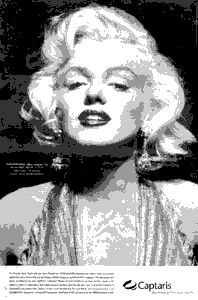
Week 3 Spectacle, Stars and Genre
9/13 The Wizard of Oz (Victor Fleming, 1939), Buffy Episode "Once More With Feeling"(2002)
9/15 Clips: Singin' in the Rain (Stanley Donen/Gene Kelly,1952), Shanghai Knights (David Dobkin, 2003), Moulin Rouge (Baz Luhrmann, 2001), Chicago (Rob Marshall, 2002)
Read:
- FE: Chapter 8: Rituals, Conventions, Archetypes, and Formulas: Movie Genres, 288-324, Chapter 12: Preparing to Write about a Film, 484-491
- X: Richard Dyer, "Entertainment and Utopia" (Movies and Methods II)
- X: Tom Gunning, "The Aesthetics of Astonishment"(FTC)
- Recommended: FA: Chapter 4: Film Genres
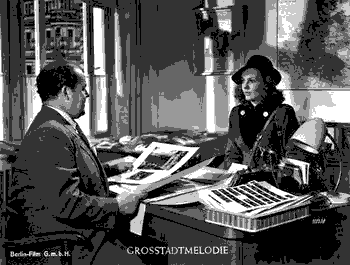
Week 4 Thinking about Images: Mise-en-Scène
9/20, Written on the Wind (Douglas Sirk, 1956)
9/22 Clips: M (Fritz Lang, 1931), Metropolis (Fritz Lang, Germany, 1926), The Blue Angel (Josef von Sternberg, 1930), Marriage of Maria Braun (R.W. Fassbinder, 1978), Juliet of the Spirits (Frederico Fellini, 1965), Down with Love (Peyton Reed, 2003)
Read:
- FE: Chapter 2: Exploring a Material World: Mise-en-Scène, 41-74, Chapter 12: Writing a Film Essay, 492-501
- X: Walter Benjamin, "The Work of Art in the Age of Mechanical Reproduction" (FTC)
- X: Andreas Huyssen, "The Vamp and the Machine" (After the Great Divide)
- X: Thomas Elsaesser, "Tales of Sound and Fury" (Movies and Methods II)
- Recommended: FA: Chapter 6 and "German Expressionist School of Filmmaking," 406-408
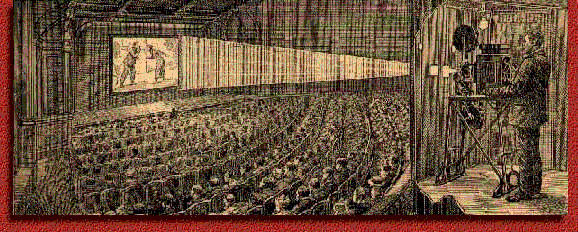
Week 5 Thinking about Moving Images: Cinematography
9/27 The Birds (Alfred Hitchcock, 1963)
9/29 Clips: Wavelength (Michael Snow, 1967), Menschen am Sonntag (Siodmak Brs., 1930) Blade Runner (Ridley Scott, 1982), Bram Stoker's Dracula (Francis Ford Coppola, 1992), Gladiator (Ridley Scott, 2000)
Read:
- FE: Chapter 3 Seeing through the Image: Cinematography, 75--109, Chapter 12: Researching the Movies, 502-516
- X: Maya Deren, "Cinematography: The Creative Use of Reality" (FTC)
- Recommended: FA: Chapter 7: The Shot: Cinematography
FILM ANALYSIS PAPERS DUE IN MY OFFICE BY FRIDAY, 5PM
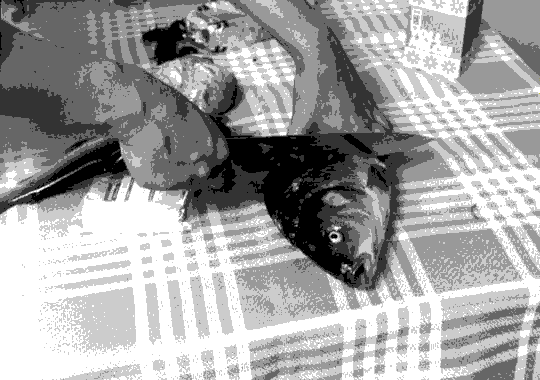
Week 6 Editing: Continuity and Discontinuity
10/4 Meshes of the Afternoon (Maya Deren/Alexander Hammid, 1943), Blow-Up (Michelangelo Antonioni, Italy, 1966)
10/6 Clips from Ballet Mécanique (Ferdinand Leger, 1924), Berlin- Symphony of a City (Ruttmann, 1927), His Girl Friday (Howard Hawks, 1940), The Limey (Steven Soderberg, 1999), Strike (Sergei Eisenstein, 1925), Invisible Adversaries (Valie Export, 1977), Yesterday Girl (Alexander Kluge, 1966)
Read:
- FE: Chapter 4 Relating Images: Editing, 110-165, Chapter 11: Film Theory and Historical Content, 437-449
- X: Janey Place and A.S. Peterson, "Some Visual Motifs in Film Noir" " (Movies and Methods I)
- Recommended: FA: Chapter 8: The Relation of Shot to Shot: Editing, Chapter 5 128-138.
October Break
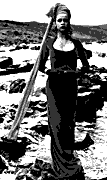
Week 7 Feminist Film Theory: Authorship, Image, Spectatorship
10/18 Gentlemen Prefer Blondes (Howard Hawks, 1953), The Virgin Machine (Monika Treut, Germany, 1988)
10/20 Clips: Blonde Venus (Sternberg, 1932), Gilda (Charles Vidor, 1946), The Piano (Jane Campion, 1992), Bagdad Café (Percy Adlon, 1988), Thelma and Louise (Ridley Scott, 1991) Whale Rider (Niki Caro, 2003), Antonia's Line (Marleen Gorris, 1995), The Body Beautiful (Ngozi Onwurah, 1991)
Read:
- FE: Chapter 11: Critical Questions in Contemporary Film Theory, 450-460
- X: Laura Mulvey, "Visual Pleasure and Narrative Cinema" (FandF)
- X: Claire Johnston, "Women's Cinema as Counter Cinema" (FandF)
- X: Maureen Turim, "Gentlemen Consume Blondes" (FFC)
- X: E. Ann Kaplan, "Is the Gaze Male?" (FandF)
- Recommended: Lucie Arbuthnot and Gail Seneca, "Pre-Text and Text in Gentlemen Prefer Blondes" (FFC)
MIDTERM HANDED OUT
UNIT II: The Politics of Sound and Image
"The subjects reproducible in the kinetoscope include the most rapid movements, such as quick dancers, blacksmiths hammering on the anvil, &c, or incidents of ordinary life involving much gesture and change of facial expression, and nothing can be more amusing than to see all these shown to the life by the images on the screen, or by the pictures viewed through the lens, especially if, at the same time, the phonograph is made to emit the corresponding sounds." (Discoveries and Inventions of the Nineteenth Century, by Robert Routledge, B.Sc., F.C.S. )
10/25 Tout Va Bien (Jean-Luc Godard, and Jean-Pierre Gorin, France, 1972)
10/27 Clips: Amarcord (Frerico Fellini, 1974), Nashville (Robert Altmann, 1975), The Conversation (F.F. Coppola, 1974), Ten Minutes to Live (Oscar Micheaux, 1932), The Lost Honor of Katharina Blum (Volker Schlöndorff/Margarete von Trotta, 1975), The Lost World: Jurassic Park (Steven Spielberg, 1997), Invisible Adversaries (Valie Export, 1977), X-Files clip
Read:
- FE: Chapter 5 Listening to the Cinema: Film Sound, 166-213
- X: Jean-Luc Cornolli and Jean Narboni. "Cinema/Criticism/Ideology" (FTC)
- X: John Belton, "Technology and Aesthetic of Film Sound" (FTC)
- Recommended: FA: Chapter 9, Chapter 5, 138-144, Chapter 12 "The French New Wave"
MIDTERM DUE

Week 9 "Reality" Television and Live Webcam
11/1 Survivor and Big Brother samples
Watch one each of any talk show, live sports event, live news cast and so-called reality-show on TV, and get online to check websites for live and reported coverage (Big Brother 2 USA, Survivor Allstars USA)
11/3 Clips: Paper Tiger Television, reality show slips
Read:
- The Television Encyclopedia (specifically "Reality Programming")
- X: John Ellis, "Broadcast TV as Sound and Image" (FTC)
- X: Jane Feuer, "The Concept of Live Television" Ideology as Ontology" (Regarding Television)
- X: Sasha Torres, "King TV" (Living Color)
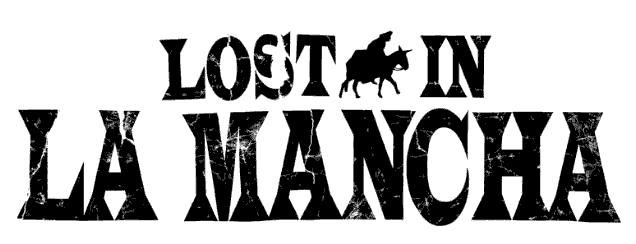
Week 10 Documentary Deconstructed - Group Projects
11/8 Daring to Resist (Martha Lubell, 2000), History and Memory: For Akiko and Takashige (Rea Tajiri, 1992)
11/10 Clips: Reassemblage (Trinh T. Minh-ha, 1982), Nanook of the North (Robert Flaherty, 1922), The River (Pare Lorentz, 1937), Thin Blue Line (Errol Morris, 1987), Performing the Border (Ursula Biemann, 1998), Bowling for Columbine (Michael Moore, 2001), A Mighty Wind (Christopher Guest, 2003)
Read:
- FE: Chapter 7: Other Cinematic Shapes: Documentary and Experimental Films, 257-287
- X: Michael Renov, "Toward a Poetics of Documentary" (Theorizing Documentary)
- X: Trinh T. Minh-ha, Interview with Constance Penley and Andrew Ross (Framer Framed)
- Recommended: FA: Chapter 5 , 110-128
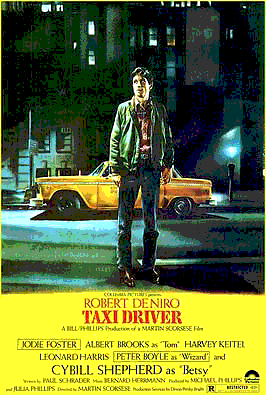
11/15 Taxi Driver (Martin Scorsese, 1976)
11/17 Clips: A Personal Journey through American Cinema (Scorsese), Bonnie and Clyde (Arthur Penn, 1967), Easy Rider (Dennis Hopper, 1969), Halbe Treppe (Grill Point, Andreas Dresen, 2002)
Read:
- FE: Chapter 9: Film History as Periodization, 352-364
- X: Amy Taubin, "Taxi Driver"
- X: Martin Scorsese, "Taxi Driver" (Scorsese on Scorsese)
- Recommended: FA: Chapter 12 "The New Hollywood and Independent Filmmaking"
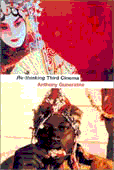
Week 12 Third Cinema and New National Cinemas
11/22 Black Girl (La Noire de…, Ousmane Sembene, Senegal, 1966), The Apple (Samira Makhmalbaf, France/Iran, 1998)
11/24 Clips: Memories of Underdevelopment (Memorias del subdesarrollo, Tomás Gutiérrez Alea, Cuba, 1968), Silences of the Palace (Saimt el Qusur, Moufida Tlatli, 1994), Bahji on the Beach (Gurinder Chadha, 1993), Kurz und Schmerzlos (Short Sharp Shock, Fatih Akim, 1998)
Read:
- FE: Chapter 10: Global and Local: Inclusive Histories of the Movies, 365-415
- X: Fernando Solanas and Octavio Gettino, "Towards a Third Cinema"
- X: Robert Stam, Luoise Spence, "Colonialism, Racism and Representation,: An Introduction" (FTC)
Thanksgiving Break
Week 13 Media Futures - Group Projects
11/29Festen (The Celebration, Thomas Vinterberg, Denmark, 1998), Girl Power (Sadie Benning, Video, 1992)
12/1 Clips: Patchwork Girl (Hypertext Novel), Paper Tiger TV (Alexander Kluge), I-Movies, Fan-Sites on the Internet etc.
Read:
- FE: Chapter 11: New Directions for Film Studies, 460-473
- X: Dogme 95 Manifesto
- X: Martha Rosler, "Video: Shedding the Utopian Moment" (Illumination of Video Art)
- X: Jennifer González, "The Appended Subject: Race and Identity as Digital Assemblage" (Race in Cyberspace)
FINAL EXAM





- Blonsky, Marshall. Ed. On Signs. Baltimore: The Johns Hopkins University Press, 1985.
- Bordwell, David and Kristin Thompson. Film Art. An Introduction. New York: McGraw Hill, 2001. 6th edition. Website: http://www.mhhe.com/filmart.
- Braudy, Leo and Marshall Cohen. Eds. Film Theory and Criticism. Oxford: Oxford University Press, 1999.
- Cook, Pam and Philip Dodd. Eds. Women and Film. Philadelphia: Temple University Press, 1993.
- Cook, Pam and Mieke Bernink. Eds. The Cinema Book. London : BFI Pub., 2000.
- Corrigan, Timothy and Patricia White. The Film Experience. Boston/NY: Bedford St. Martin, 2004.
- Erens, Patricia. Ed. Issues in Feminist Film Criticism. Bloomington: Indiana University Press, 1990.
- Hall, Doug and Sally Jo Fifer. Eds. Illuminating Video: An Essential Guide to Video Art. New York: Aperture/Bay Area Video Coalition, 1990.
- Hill, John and Pamela Church Gibson. Eds. The Oxford Guide to Film Studies. Oxford: Oxford University Press, 1998.
- Huyssen, Andreas. After the Great Divide. Bloomington: Indiana University Press, 1986.
- Kaplan, E. Ann. Ed. Regarding Television. Frederick, MD: American FIlm Institute, 1983.
- Kaplan. E. Ann. Ed. Feminism and Film. Oxford: Oxford University Press, 2000.
- Kolko, Beth E. and Lisa Nakamurea, Gilbert B. Rodman. Eds. Race in Cyberspace..New York: Routledge, 2000.
- Konigsberg, Ira. The Complete Film Dictionary. New York : Penguin Reference, 1997.
- Manovich, Lev, "What is Digital Cinema." The Visual Cultures Reader. London/NY: Routledge, 2002.
- Monaco, James. How to read a Film. Movies, Media, Multimedia.Oxford: Oxford University Press, 2000. 3rd edition.
- Neale, Steve and Murray Smith. Eds. Contemporary Hollywood Cinema. New York: Routledge, 1998.
- Nichols, Bill. Ed. Movies and Methods. Vol. I. Berkeley: University of California Press, 1976.
- Nichols, Bill. Ed. Movies and Methods. Vol. II. Berkeley: University of California Press, 1985.
- Nowell-Smith, Geoffrey. Oxford History of World Cinema. Oxford: Oxford University Press, 1996.
- Renov, Michael. Ed. Theorizing Documentary. New York: Routledge, 1993.
- Rosen, Philip. Ed. Narrative, Apparatus, Ideology: A Film Theory Reader. New York: Columbia University Press, 1986.
- Stam, Robert. Film Theory. An Introduction. Oxford: Blackwell, 2000.
- Thompson, David and Ian Christie. Eds. Scorsese On Scorsese. London: Faber and Faber.1989.
- Tobing Rony, Fatimah. The Third Eye. Race, Cinema, and Ethnographic Spectacle. Durham: Duke University Press, 1998.
- Torres, Sasha. Ed. Living Color. Race and Television in the United States. Durham: Duke University Press, 1998.
Site created and
maintained by Sunka Simon, last updated May 7,
2004.